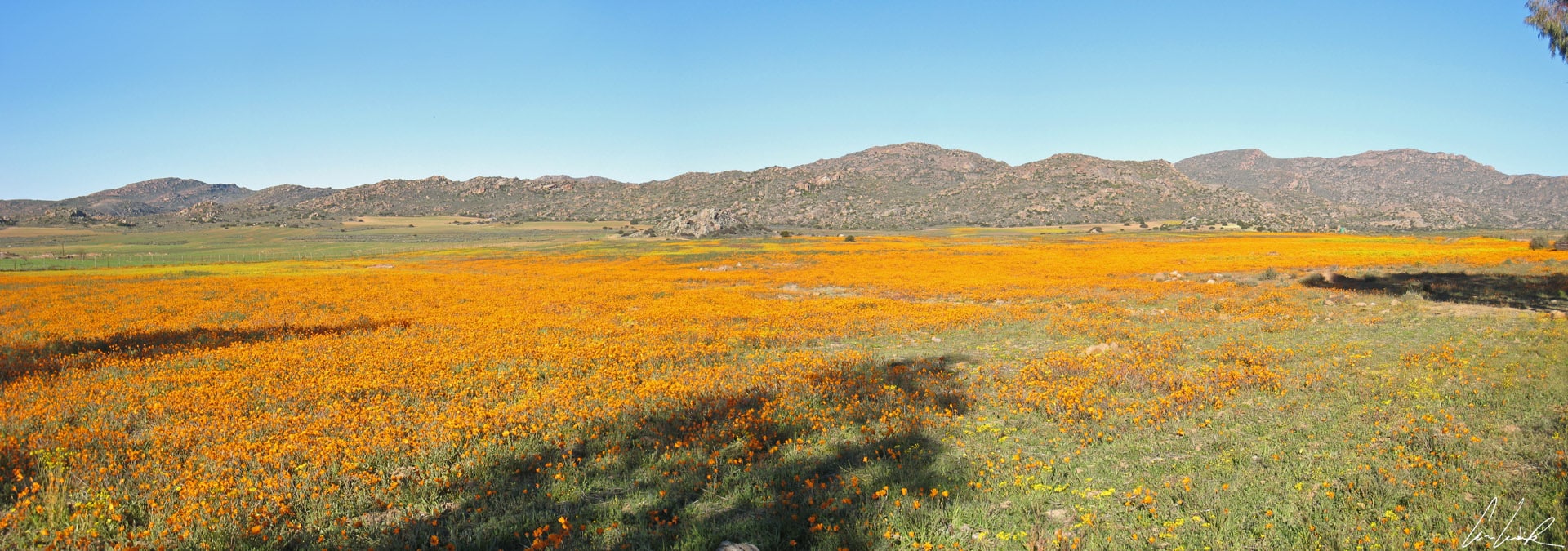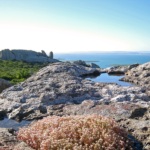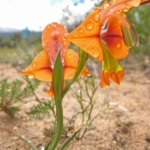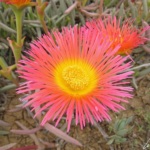Sanibonani, Kunjani ? That’s how we say it in Swati !
Welcome to the West Coast National Park, located 75 miles North of Cape Town. It covers 106 square miles between the Atlantic Ocean and the R27 from the town of Yzerfontein in the South and up to the azure blue Langebaan lagoon, one of the largest wetlands in South Africa. The Park is renowned for hosting millions of birds, big and small, and is also well-known for its wildflowers. Although concealed behind a black mask (but where is “Tornado” ?), we recognize a Kittlitz’s Plover looking for some beetles, flies and other insects in the sandy soil for his lunch. The plover performs “foot-trembling” behavior, an original foraging technique to expose prey. The technique consists of holding one of the legs forward at a 45° angle and then vibrating the foot and tarsus rapidly so that the victim comes out of the sandy soil (ok, I admit it, you have to be flexible !) Nearby, perched on a branch, sits a Malachite Sunbird. It is easily recognizable by its iridescent blue plumage and its long, black, thin downward-curving bill about 1.5 inches long. The lagoon attracts numerous migratory birds, taking advantage of the water to rest and to find abundant food. Seagulls, flamingos, cormorants, egrets… are common.

West Coast National Park, Flamingos
Another major attraction of the West Coast National Park, the Postberg Nature Reserve, is located in the north of the peninsula. The Postberg is open to the public only during the two spring months of August and September. The highlight of the Postberg conservation area, besides being a resting stop for thousands of migrating birds, is undoubtedly the impressive and exceptional carpet of annual Spring wildflowers, conferring on the Reserve a unique multicolored landscape several square miles in size. The flower season is a delight for professional and amateur photographers. As Lolo sings, “je m’souviens, on avait des chansons, des paroles / comme des pétales et des corolles…” translated as “I remember, we had songs, lyrics / like petals and corollas…” lyrics by the French singer Laurent Voulzy (Le pouvoir des fleurs). The Nature Reserve is rich in fauna. Visitors can glimpse bonteboks, Oryx, zebras and other species of antelopes. A landscape unique in the world with the ocean on one side and rock formations on the other.
But it is time to leave the Atlantic Ocean and rush inland to the Cederberg Wilderness Reserve, a UNESCO World Heritage Site since 2004. The Cederberg region, about 300 miles North of Cape Town, is barely on the tourist map of South Africa because, for many visitors, South Africa is limited to two points of interest: animal reserves and Cape Town. The richness of the Cederberg is readily accessible from Cape Town for those who are not put off by a few hours in a four-wheel drive vehicle on partly unpaved roads. The Cederberg is dominated by rugged mountains, extraordinary rock formations, and oxide-stained red sandstone cliffs providing an intense orange-reddish color at sunset. The atmosphere is serene as the light falls slowly…

Réserve naturelle du Cederberg, sunset
The Cederberg Wilderness Reserve is a true paradise for hikers and rock-climbing enthusiasts. Valleys and peaks follow one another from North to South over a hundred miles. The spectacular sandstone formations weathered by mother nature take strange and fascinating shapes, notably on the side of The Stadsaal, a series of interconnected caves featuring the San people’s astonishing rock art. What a beautiful setting for a movie ! One almost expects to relive the scene starring Rachel Welch in the 1966 British film “A million years before J.C“… And a little away from these strange forms, could it be Elephant Rock ? A must-see for any visitor to the Cederberg. Besides the spectacular landscape and rock formations, the Cederberg Wilderness Reserve offers a vibrant, multihued floral display of many different species. You can pick any color you like from the orange of the Gladiolus equitans to the eye-catching violet of the Sparaxis metelerkampiae and the bright pink of Jordaaniella spongiosa ? Another highlight is the Red Bush or Rooibos also known under its scientific name Aspalathus linearis. The plant grows wild in this region and is cultivated nowhere else in the world… The shrub of the acacia family is endemic and fiercely attached to the area. The United States, Australia, and China tried to cultivate the Red Bush, but their attempts have been futile. Many recipes use this red herb. Its thin red-brown leaves produce an herbal tea with medicinal virtues. This “red tea” was less expensive than the “black tea” brought from the East by ship… It offered residents an unofficial “national” drink competing with fashionable Londonian tea. Among the fauna, the leopard is the largest predator of the reserve, but only the lucky few may catch a glimpse of him, except on a sign…

Namaqualand, Carpet of multicolored wildflowers
Our last floral glimpse before heading even further north to Augrabies: Namaqualand (Namakwaland in Afrikaans). Namaqualand is an arid region on the West coast of South Africa stretching over 600 miles along the coast between the Northern edge of the province of Cape Town and the Karas region of Namibia further to the North. Namaqualand covers an area of 170,000 square miles. This region displays one of the most arid landscapes in South-West Africa, but this land of desiccated plains and desolate mountains undergoes a metamorphosis once a year: larva turn into butterflies ! In the early Springtime, from August to September, the arid plain becomes covered with a carpet of multicolored wildflowers (Orange is the New Black ?). This metamorphosis is known as Namaqualand daisy season. The entire monochrome surface of the desert changes as the Spring flowers bloom on the previously barren landscape. A phenomenon that can be explained by the survival of plants that managed to resist the blazing summers when fifty million years ago (not so young !) this previously humid coast became a desert due to climate change.

Namaqualand, the Oryx Gazella or Gemsbok
The true descendant of the unicorns, but with two long, V-shaped, corrugated horns averaging 85 inches in length, the Oryx Gazella or Gemsbok appears in this magical environment. A large antelope of the Oryx genus, it is sometimes referred to as an antelope even though not scientifically classified as such. Its main predators are lions and leopards… even so, even lions, if they are lovers of their flesh, approach the gemsboks with caution because their horns are fierce !
Hambakahle






















OH! For so long my husband has been telling me about the Cederberg Wilderness Reserve. I heard so many amazing things and having seen this article, it made me want to get there even more! I do love a bit of a flower power 😀
The Cederberg Wilderness Reserve is really a beautiful place to visit 🙂 I have particularly enjoyed the spectacular sandstone formations weathered by mother nature and the vibrant floral display… and of course the drink of the Red Bush !
Very interesting, this was one place I had to skip on my time in South Africa so it was great to see your lovely photos.
I really love the Cederberg Wilderness Reserve because it is a true paradise for hikers and rock-climbing enthusiasts 🙂
Those Oryx Gazella look so stunning! I can’t believe you were able to get so close! I absolutely love UNESCO sites and this looks like it definitely fits the bill!
I love to visit UNESCO sites as well ! I agree, the true descendant of the unicorns with two long, V-shaped is stunning 🙂
I have to admit that I burst out laughing at the point where you wrote ‘descendant of unicorns’. It was such a perfect description for that photograph. My husband has been after me to plan a trip to South Africa. Unfortunately the cost of traveling there doesn’t seem to fall in our budget as of yet. Hopefully soon.
South Africa is an ever-surprising country… surprising in its geography as well as in its diverse flora and fauna ! If you manage to get there – hopefully soon :-),take your binoculars, try to spot “Cheetah” !
What beautiful scenery and interesting wildlife, unlike anything we have in Chicago, that’s for sure! I have heard California has wildflower blooms like this, but I haven’t seen them yet. Someday…
I just read few articles on this “super bloom” in California 🙂 The Spring is in the air and the wildflowers are blooming in Southern California. Apparently, the eastern part of the region is experiencing a “super bloom” unlike anything seen in the area since 2005 !! The desert is exploding with color right now :-). I wish I could be there…
I love all your wildlife and nature photos. It’s nice to see a lot of different flowers growing just in one place. Definitely not the type I commonly see in flower markets. And it always warms my heart when I see the animals in their natural habitat.
I have never been to South Africa (only Morocco), so this National Park is something I will keep in mind when we plan to visit there. 🙂
Thank you 🙂 The Spring is in the air and the wildflowers are blooming in Namaqualand… The desert is exploding with color: it is an amazing experience to see a carpet of multicolored wildflowers !
The fauna of South Africa are profuse, and animals move freely from one area to another.
Oh wow this looks like such a wonderful place! Sadly we missed it somehow when we were in SA, did not even know it´s there at the time 🙁 Nice photos, love the elephant looking rock 😉
You missed The Cederberg Wilderness Reserve 🙁 I love this area, particularly the spectacular sandstone formations weathered by mother nature… so strange and fascinating shapes such as the “Elephant Rock”. I could hike there few hours 🙂 looking for the spectacular landscape and rock formations !
Beautiful view. and the flamingos!! I could walk here for hours… pure beauty of mother earth..
South Africa is surprising in its geography (Between oceans, mountains, deserts) as well as in its diverse flora and fauna ! It’s magical 🙂
Wow! Your pictures are so gorgeous! South Africa is on the list for sure! My friend was actually telling me that we should go to South Africa soon today! 😉
Thank you 🙂 South Africa is really an incredible journey. I wish you will get there soon. This is a lovely country !
It was interesting to read about the transformation of desert into flower carpet and how those are the same flower species from 50 million years ago! I had read that same happens in the USA, so when seeing the picture with flowers I thought – this must be similar! And then read your description. Good to know the season when it happens, perhaps can visit some time when this happens!
During the months of August and September (predominantly, but sometimes also into October), Namaqualand’s is exploding with color: it is an amazing experience to see a carpet of multicolored wildflowers ! There is currently a “super bloom” in California 🙂 The Spring is in the air and the wildflowers are blooming in Southern California. Apparently, the eastern part of the region is experiencing a “super bloom” right now.
Such a beautiful place! I’m hoping to make it to Cape Town soon, so i’ll definitely make a stop here when I do. We love to hike, and the scenery isn’t bad either 🙂
The Cederberg Wilderness Reserve is a true paradise for hikers and rock-climbing enthusiasts :-). An extraordinary adventure I recommend to you !
South Africa is so high on my list! This looks so incredible!
Between oceans, mountains, deserts, and flowers, prosperous cities and townships, the Republic of South Africa is an ever-surprising country ! You will love it 🙂
I must admit, I’ve wanted to go to Cape Town for a long time! Now I have another place in SA to add to my list. The landscape looks absolutely beautiful and so unique – I haven’t seen anything like it before. Love your photos!
I love Cape Town which is definitively a little paradise lost between sea, mountains, and two oceans ! But the Cederberg Wilderness Reserve is also a true paradise: it offers a spectacular landscape and rock formations as well as a vibrant, multihued floral display of many different species :-). So see it by yourself at least once !
Been dreaming of visiting South Africa, particularly in Cape Town. Would love to see those wildlife in the reserve. Those wildflowers are very attractive. 🙂
I hope your dreams come true too 🙂
The places you visited all look stunning and I’ve never heard of any of them. I’d love to see flamingoes in the wild! The rocky hikes you mentioned look great too.
Sounds great 🙂 I hope to inspire you to be adventurous and to enrich your life by travelling to these places in South Africa !!
Namaqualand daisy season looks so breathtaking! Do you know how long it lasts? I’d absolutely love to witness this in person – have yet to explore the continent of Africa properly but SA is high up on my bucket list!
During the months of August and September (predominantly, but sometimes also into October),Namaqualand’s Spring flora bursts forth with a riot of colors that bewitches the eyes with images of dazzling brilliance ! So see it by yourself at least once 🙂
Your photos are simply stunning! Daisy season looks to die for, I had never heard of any of these places before this post, thanks for sharing!!
Thank you :-). The “Superbloom” is really an annual Flower Show !The region’s predictable yearly rainfall is what makes Namaqualand one of the best flower shows around 🙂
This is very interesting, You are a very skilled blogger. I’ve joined your rss feed and look forward to seeking more of your fantastic post. Also, I’ve shared your site in my social networks!
Thank you :-). Through my blog, I hope to inspire people to be adventurous and to enrich their lives by captivating the power of travel and cultural exploration…
So nice to read about a different side of South Africa, close to Cape Town yet different from what I’ve researched so far. Thanks for sharing, it was very inspiring!